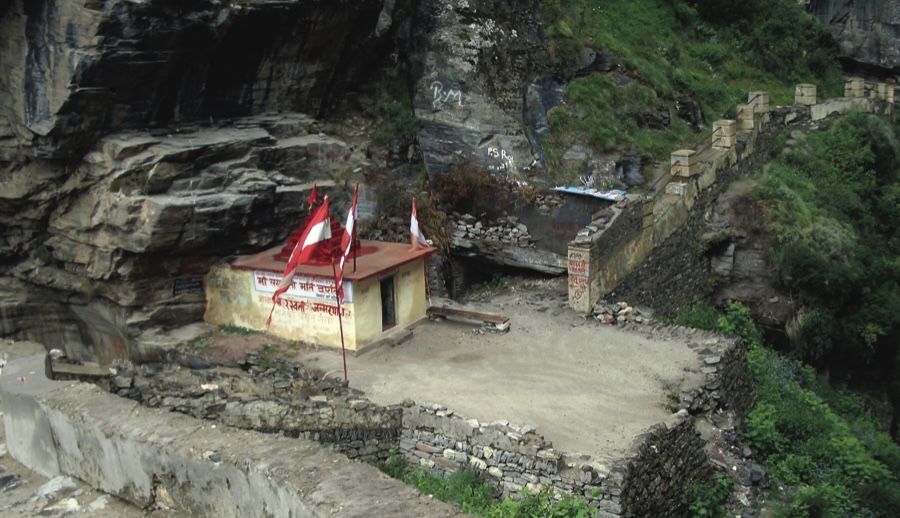BY PRITHIVIRAJ BAHADURSINGH
The Himalayas are said to be the abode of the Gods. Their mighty, indomitable presence alone is enough to lift our hearts to sublime heights. Over the centuries they have been fertile ground, producing many Self-Realized saints and sages. I count myself lucky to have been able to visit the magnificent Himalayas and offer my humble salutations to these rishis.
We set off as a group of seven from Chinmaya Mission, London, on a quest to visit all four of the Himalayan pilgrimage destinations known as the Chardham: Yamunotri and Gangotri, both sacred to Devi; Badrinath, sacred to Lord Vishnu; and Kedarnath, sacred to Lord Siva. Against prevailing advice, we began in July, 2005, after the monsoon rains had started, which meant hazardous road conditions and landslides. But it also meant clean air, minus dust and smoke, which allowed for spectacular sights.
We were probably seeking to do the impossible, but we set out with faith and a vibrant spirit. Although we did not reach Yamunotri, which would have required a six-kilometer hike, we were far from being disappointed: our pilgrimage to Gangotri, Badrinath and Kedarnath will inspire us forever. Our very entry into the Himalayas was a pilgrimage in itself: we stopped at Haridwar and Rishikesh, where the evening arati worship to Mother Ganga is an experience not to be missed.
I always knew that certain places have spiritual vibrations, but on our trip I became overwhelmingly convinced of the power of our ancient rishis and saints. Temples such as Kedarnath and Badrinath have their own powerful vibrations, but there was something remarkable and uplifting about the dwelling places of our saints. We were fortunate enough to visit three such places in addition to the temples.
A short drive from Badrinath is the small village of Mana. A brief walk in the thin air through the mountain village took us to Shri Vyasa Cave and Shri Ganesha Cave. Then another short walk and we all stood in awe at the origin of the mighty Sarasvati River. Next to the river is a small Ma Sarasvati temple where we made offerings. Ma Sarasvati is the Goddess of Learning. It is no surprise that Shri Ved Vyasa lived so close to Her.
Ved Vyasa is one of the greatest saints of our tradition. The volume of his contribution to our culture and civilization is unparalleled. He composed the great Maha-baha-rata, Bhagavad Gita and the Shrimad Bhagavatam. As the story goes, he dictated the Mahabharata to Lord Ganesha, who wrote it down with His broken tusk. Vyasa Cave and Ganesh Cave are the actual places where this writing took place. One may believe that this is a myth, but on entering the cave of Shri Ved Vyasa, who lived thousands of years ago, one is totally overcome by the spiritual power of this abode. One can feel his divine presence. I remembered the praise to Ved Vyasa in the Gita Dhyanam, and I thought to myself, “How true those verses really are.” In the cave is a consecrated statue of Ved Vyasa and, quite appropriately, there is a resident brahmachari who daily recites Sanskrit verses.
I learned from my friends that countless saints have visited Ved Vyasa Cave over the centuries. Swami Tapovan (1888-1957), the Satguru of Swami Chinmayananda, often visited Ved Vyasa Cave to meditate as a respite from his wanderings in the Himalayas. I was so humbled to know this and to have been able to visit this divine place.
We also visited Swami Tapovan’s retreat. He had a small hut in Uttarkashi, on the banks of the Ganga, just a short walk from the Kashi Vishwanath Temple. A Chinmaya ashram has been built around it, but the original hut is still preserved. The hut is normally closed; but for Guru Purnima in July, when devotees honor their guru, it was opened up for worship, and we were able to see the inside. The feeling of his dwelling place is the same as at Ved Vyasa Cave, one of subtle, calm and deeply spiritual vibrations.
At Gangotri we visited Swami Tapovanji’s ashram, where Swami Chinmayananda studied with him. At present Swami Sundarananda, a direct student of Swami Tapovanji, lives there. Swamiji is famous for his outstanding photographs of the Himalayas. During our visit, he opened up the inner apartment where Swami Tapovanji lived and meditated. This was the third time that I experienced that same overwhelming spiritual feeling. It convinced me of the power of our saints.
We are deeply indebted to our great saints for the contributions they have made for our growth and spiritual evolution. It is a blessing to be able to visit the places where they lived and even greater is to be in their divine presence. I hope that everyone in some way may experience and be inspired by their greatness and divinity.


